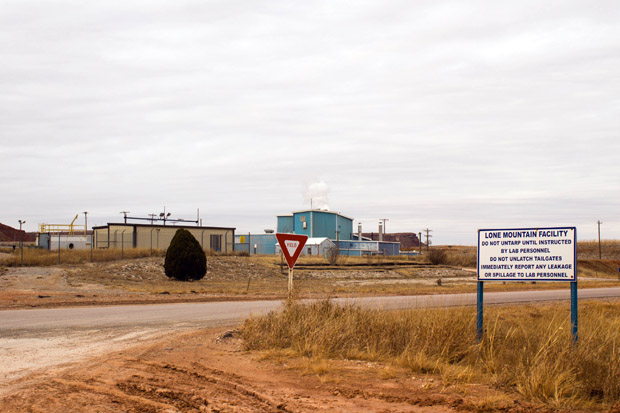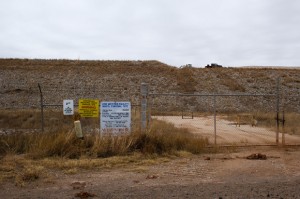The Reason Toxic ‘Releases’ Are Up in Oklahoma, and Why It’s Not That Scary
-
Joe Wertz

Joe Wertz / StateImpact Oklahoma
Toxic waste from New York, New Jersey and Wisconsin is brought by rail to Oklahoma, where it's treated and stored at the Lone Mountain Landfill.
New data from the federal government show a drop in the amount of toxic chemicals being released into the nation’s air, water and land. In Oklahoma, however, so-called toxic “releases” have soared.
But it’s not as scary as it sounds.
Major County is one of the sparsest, least populated counties in Oklahoma. But the county lives up to its name in other ways. Thirty-six million pounds of toxic chemicals were released here in 2012, data from the U.S. Environmental Protection Agency show. That’s more than every other waste-storing county in Oklahoma combined, and more than the totals of half the states in the nation.

Joe Wertz / StateImpact Oklahoma
The Lone Mountain landfill near Waynoka, Okla.
Those chemicals —which include truckloads of contaminated soil and waste from factories, military installations and other industrial sites — go through a treatment regimen that includes mixing the waste with coal ash, kiln dust and other reagents to keep it from getting into the air or leeching into the soil, where it could pollute water supplies.
“Basically, it’s cement,” says the landfill’s compliance officer Lee Grater, describing the state of the waste before it can be stored.
The EPA’s Toxic Release Inventory report — the so-called TRI report — shows a 12 percent decline in total toxic releases from 2011 to 2012, nationally. But Oklahoma’s total toxic releases increased 64 percent during the same time period.
Federal and state environmental regulators keep a close eye on this kind of toxic waste. Even if the waste is treated and stored, properly, on top of layers of thick plastic and buried in the middle of the empty Oklahoma prairie, it still gets recorded as a “toxic release.”
That skews the numbers, says Monty Elder with the State Department of Environmental Quality.
“Our overall releases are up, and it’s really due to an anomaly.”
The Lone Mountain Landfill is the anomaly. Here’s why: Most of this waste isn’t even from Oklahoma.
“They’re dredging the Hudson River for a Superfund site,” Elder says. “And that material that’s dredged out of the Hudson River is actually being taken to the Lone Mountain facility.”
Phillip Retallick, the senior vice president of compliance and regulatory affairs at Clean Harbors, the Massachusetts-based company that owns the Oklahoma landfill, says waste is also imported from sites in Wisconsin and New Jersey.
“There are no releases to the environment,” Retallick says. “It’s being disposed of in a landfill that meets all the federal and state requirements. But, for the purposes of the TRI report, it is a release.”
If you read the TRI reports, you see that a lot of this waste contains PCBs, which were used in early-generation transformers, motors and electronics. It’s toxic, but Elder says it’s not considered hazardous — it’s not an immediate threat to people.
“It’s an appropriate place to put it in that all the safeguards you need for making sure that waste is disposed of and doesn’t get into the environment are there.”
There could be another reason there’s been a waste-importing boom in Major County: It now costs less to bring it here. Oklahoma lawmakers in 2013 passed a law slashing the fees the landfill was required to charge, from $9 per ton to $1.25 per ton.

